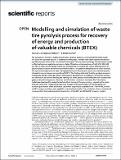| dc.contributor.author | Cao, Yan | |
| dc.contributor.author | Nakhjiri, Ali Taghvaie | |
| dc.contributor.author | Sarkar, Shahin | |
| dc.date.accessioned | 2023-05-03T13:47:30Z | |
| dc.date.available | 2023-05-03T13:47:30Z | |
| dc.date.copyright | 2023 | |
| dc.date.issued | 2023-04-13 | |
| dc.identifier.citation | Cao, Y., Taghvaie Nakhjiri, A. & Sarkar, S. (2023) Modelling and simulation of waste tire pyrolysis process for recovery of energy and production of valuable chemicals (BTEX), Scientific Reports, 13, pp. 1-13. Available at: https://doi.org/10.1038/s41598-023-33336-3 (Accessed 3 May 2023). | en_US |
| dc.identifier.issn | 2045-2322 | |
| dc.identifier.uri | https://research.thea.ie/handle/20.500.12065/4498 | |
| dc.description.abstract | The pyrolysis oil fraction is highly attractive for pyrolysis products. A simulated flowsheet model of a waste tire pyrolysis process is presented in this paper. A kinetic rate-based reaction model and equilibrium separation model are created in the Aspen Plus simulation package. The simulation model is effectively proven against experimental data of literature at temperatures of 400, 450, 500, 600 and 700 °C. Also, the developed model was employed to investigate the impact of temperature on the pyrolysis procedure and demonstrated that there is an optimum temperature for chain fractions. The optimum temperature to have the highest amount of limonene (as a precious chemical product of waste tire pyrolysis process) was found 500 °C. The findings indicated that the pyrolysis process is ecologically benign, although there is still space for development. In addition, a sensitivity analysis was carried out to see how altering the heating fuel in the process would affect the non-condensable gases produced in the process. Reactors and distillation columns in the Aspen Plus® simulation model was developed to assess the technical functioning of the process (e.g., upgrading the waste tires into limonene). Furthermore, this work focuses on the optimization of the operating and structure parameters of the distillation columns in the product separation unit. The PR-BM, as well
as NRTL property models, were applied in the simulation model. The calculation of non-conventional components in the model was determined using HCOALGEN and DCOALIGT property models. | en_US |
| dc.format | application/pdf | en_US |
| dc.language.iso | eng | en_US |
| dc.publisher | Springer Nature Limited | en_US |
| dc.relation.ispartof | Scientific Reports | en_US |
| dc.rights | Attribution 3.0 United States | * |
| dc.rights.uri | http://creativecommons.org/licenses/by/3.0/us/ | * |
| dc.subject | chemical engineering | en_US |
| dc.subject | energy science and technology | en_US |
| dc.title | Modelling and simulation of waste tire pyrolysis process for recovery of energy and production of valuable chemicals (BTEX) | en_US |
| dc.type | info:eu-repo/semantics/article | en_US |
| dc.contributor.affiliation | Technological University of the Shannon: Midlands Midwest | en_US |
| dc.description.peerreview | no | en_US |
| dc.identifier.doi | 10.1038/s41598-023-33336-3 | en_US |
| dc.identifier.endpage | 13 | en_US |
| dc.identifier.startpage | 1 | en_US |
| dc.identifier.volume | 13 | en_US |
| dc.rights.accessrights | info:eu-repo/semantics/openAccess | en_US |
| dc.subject.department | Department of Applied Science | en_US |
| dc.type.version | info:eu-repo/semantics/publishedVersion | en_US |


